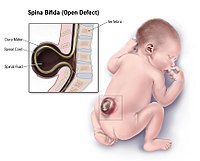
Low carbohydrate diets may increase risk of neural tube defects
Sign Up to like & getrecommendations! Published in 2018 at "Birth Defects Research"
DOI: 10.1002/bdr2.1198
Abstract: Folic acid fortification significantly reduced the prevalence of neural tube defects (NTDs) in the United States. The popularity of “low carb” diets raises concern that women who intentionally avoid carbohydrates, thereby consuming fewer fortified foods,… read more here.
Keywords: tube defects; diets may; carbohydrate diets; neural tube ... See more keywords

Overview on neural tube defects: From development to physical characteristics
Sign Up to like & getrecommendations! Published in 2018 at "Birth Defects Research"
DOI: 10.1002/bdr2.1380
Abstract: Neural tube defects (NTDs) are the second most common congenital malformations in humans affecting the development of the central nervous system. Although NTD pathogenesis has not yet been fully elucidated, many risk factors, both genetic… read more here.
Keywords: tube defects; neural tube; overview neural; defects development ... See more keywords

Summary of the 10th international conference on neural tube defects
Sign Up to like & getrecommendations! Published in 2019 at "Birth Defects Research"
DOI: 10.1002/bdr2.1519
Abstract: Neural tube defects (NTDs) are birth defects that result from errors in the process of neurulation during development. The most frequent forms include anencephaly, which is fatal and involves damage to the developing brain, and… read more here.
Keywords: tube defects; research; tube; international conference ... See more keywords

Periconceptional folic acid use prevents both rare and common neural tube defects in China
Sign Up to like & getrecommendations! Published in 2022 at "Birth Defects Research"
DOI: 10.1002/bdr2.1983
Abstract: Neural tube defects (NTDs) encompass a variety of distinct types. We assessed if the preventive effect of folic acid (FA) varied by NTD type and infant sex. read more here.
Keywords: periconceptional folic; tube defects; neural tube; folic acid ... See more keywords

Cannabidiol impairs neural tube closure in mouse whole embryo culture
Sign Up to like & getrecommendations! Published in 2022 at "Birth Defects Research"
DOI: 10.1002/bdr2.2013
Abstract: Cannabidiol (CBD) is a nonpsychoactive constituent of cannabis widely available as a dietary supplement. Previous reports that it impairs the retinoid, sonic hedgehog, and folate metabolism pathways raise concern that it may impair closure of… read more here.
Keywords: impairs neural; cannabidiol; closure; cannabidiol impairs ... See more keywords

Effect of tramadol hydrochloride on neural tube development in 48-hr chick embryos: Argyrophilic nucleolar organizing region and genetic analysis study.
Sign Up to like & getrecommendations! Published in 2022 at "Birth defects research"
DOI: 10.1002/bdr2.2137
Abstract: BACKGROUND Tramadol hydrochloride or tramadol is an opioid analgesic that acts on the central nervous system. The pregnancy category of tramadol is determined as "C" according to the Food and Drug Administration. There are no… read more here.
Keywords: neural tube; tramadol; tramadol hydrochloride; chick embryos ... See more keywords

Mechanics of neurulation: From classical to current perspectives on the physical mechanics that shape, fold, and form the neural tube
Sign Up to like & getrecommendations! Published in 2017 at "Birth Defects Research"
DOI: 10.1002/bdra.23557
Abstract: Neural tube defects arise from mechanical failures in the process of neurulation. At the most fundamental level, formation of the neural tube relies on coordinated, complex tissue movements that mechanically transform the flat neural epithelium… read more here.
Keywords: tissue movements; neurulation; tube; neural tube ... See more keywords

G-protein-coupled receptor signaling and neural tube closure defects.
Sign Up to like & getrecommendations! Published in 2017 at "Birth defects research"
DOI: 10.1002/bdra.23567
Abstract: Disruption of the normal mechanisms that mediate neural tube closure can result in neural tube defects (NTDs) with devastating consequences in affected patients. With the advent of next-generation sequencing, we are increasingly detecting mutations in… read more here.
Keywords: tube; protein coupled; neural tube; tube closure ... See more keywords

Prevalence of neural tube defects in a rural area of north india from 2001 to 2014: A population-based survey.
Sign Up to like & getrecommendations! Published in 2017 at "Birth defects research"
DOI: 10.1002/bdra.23578
Abstract: BACKGROUND Neural tube defects (NTDs) are one of the commonest birth defects. There was paucity of community-based data on occurrence of NTDs in India, especially from rural parts of the country. Against this background, the… read more here.
Keywords: tube defects; birth; prevalence; neural tube ... See more keywords

Metabolite profiling of whole murine embryos reveals metabolic perturbations associated with maternal valproate-induced neural tube closure defects.
Sign Up to like & getrecommendations! Published in 2017 at "Birth defects research"
DOI: 10.1002/bdra.23583
Abstract: BACKGROUND Valproic acid (VPA) is prescribed therapeutically for multiple conditions, including epilepsy. When taken during pregnancy, VPA is teratogenic, increasing the risk of several birth and developmental defects including neural tube defects (NTDs). The mechanism… read more here.
Keywords: vpa; embryos; neural tube; tube closure ... See more keywords

Interaction between Maternal and Paternal SHMT1 C1420T Predisposes to Neural Tube Defects in the Fetus: Evidence from Case-Control and Family-Based Triad Approaches.
Sign Up to like & getrecommendations! Published in 2017 at "Birth defects research"
DOI: 10.1002/bdra.23623
Abstract: BACKGROUND Neural tube defects (NTDs) are caused by the failure of neural tube formation which occurs during early embryonic development. NTDs are the most severe and leading cause of fetal mortality. Serine hydroxymethyl transferase (SHMT1)… read more here.
Keywords: shmt1; case; neural tube; family based ... See more keywords